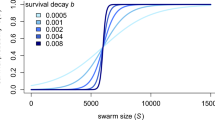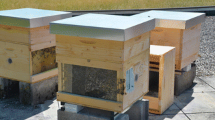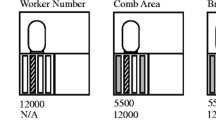Abstract
During colony founding in honey bees, a portion of a colony’s workforce (the “swarm fraction”) departs with the old mother queen in a swarm while the remaining workforce stays with a new daughter queen in the parental nest. There is little quantitative information about swarm fraction size and about how swarm fraction size affects the growth and survival of mother-queen and daughter-queen colonies. We measured (a) the swarm fraction in naturally fissioning honey bee colonies, (b) the growth and survival of mother-queen colonies as a function of swarm size, and (c) the growth and survival of mother-queen and daughter-queen colonies as a function of the swarm fraction. We found an average swarm fraction of 0.75. We also found a significant positive effect of swarm size and swarm fraction on the growth (i.e., comb built, brood produced, food stored, and weight gained) and the survival of mother-queen colonies. We found no effect of swarm fraction on the survival of daughter-queen colonies. Evidently, a honey bee colony must devote a large majority of its workforce to a swarm so that the mother-queen colony can grow sufficiently rapidly to survive its first winter.



Similar content being viewed by others
References
Bulmer M.G. 1983. Sex ratio theory in social insects with swarming. J. Theor. Biol. 100: 329–339
Caron D.M. 1999. Honey Bee Biology and Beekeeping. Wicwas Press, Kalamazoo, MI
Fell R.D., Ambrose J.T., Burgett M., De Jong D., Morse R.A. and Seeley T.D. 1977. The seasonal cycle of swarming in honeybees. J. Apic. Res. 16: 170–173
Getz W.M., Brückner D. and Parisian T.R. 1982. Kin structure and the swarming behavior of the honey bee Apis mellifera. Behav. Ecol. Sociobiol. 10: 265–270
Hirji K.F., Mehta C.R. and Patel N.R. 1987. Computing distributions for exact logistic regression. J. Am. Stat. Assoc. 82: 1110–1117
Jeanne R.L. 1991. The swarm-founding Polistinae. In: The Social Biology of Wasps (Ross K.G. and Matthews R.W., Eds), Cornell University Press, Ithaca, NY. pp 191–231
Lee P.C. and Winston M.L. 1985. The effect of swarm size and date of issue on comb construction in newly founded colonies of honey-bees (Apis mellifera L.). Can. J. Zool. 63: 524–527
Littell R.C., Henry P.R. and Ammerman C.B. 1998. Statistical analysis of repeated measures data using SAS procedures. J. Anim. Sci. 76: 1216–1231
Martin P. 1963. Die Steuerung der Volksteilung beim Schwärmen der Bienen: zugleich ein Beitrag zum Problem der Wanderschwärme. Insect. Soc. 10: 13–42
Matsuura M. and Yamane S. 1984. Comparative Ethology of Vespine Wasps. Hokkaido University Press, Sapporo, Japan
Mehta C.R. and Patel N.R. 1995. Exact logistic regression: theory and examples. Stat. Med. 14: 2143–2160
Michener C.D. 1974. The Social Behavior of the Bees. Harvard University Press, Cambridge, MA
Mitchell C. 1970. Weights of workers and drones. Am. Bee J. 110: 468–469
Morales G.S. 1986. Effects of cavity size on demography of unmanaged colonies of honey bees (Apis mellifera L.). M.Sc. Thesis, University of Guelph, Ontario
Raignier A. 1972. Sur l’origine des nouvelles sociétés des fourmis voyageuses africaines (Hyménoptères Formicidae, Dorylinae). Insect. Soc. 19: 153–170
Rangel J. and Seeley T.D. 2008. The signals initiating the mass exodus of a honey bee swarm from its nest. Anim. Behav. 76: 1943–1952
Rangel J., Griffin S.R. and Seeley T.D. 2010. An oligarchy of nest-site scouts triggers a honey bee swarm’s departure from the hive. Behav. Ecol. Sociobiol. 64: 979–987
Richards O.W. and Richards M.J. 1951. Observations on the social wasps of South America (Hymenoptera Vespidae), Trans. R. Soc. London 102: 1–170
Roubik D.W. 1989. Ecology and Natural History of Tropical Bees. Cambridge University Press, Cambridge, MA
Schneirla T.C. 1971. Army Ants: A Study in Social Organisation. Freeman Press, San Francisco, CA
Seeley T.D. 1978. Life history strategy of the honey bee Apis mellifera. Oecologia 32: 109–118
Seeley T.D. 1995. The Wisdom of the Hive. Harvard University Press, Cambridge, MA
Seeley T.D. 2010. Honeybee Democracy. Princeton University Press, Princeton, NJ
Seeley T.D. and Morse R.A. 1976. The nest of the honey bee (Apis mellifera). Insect. Soc. 23: 495–512
Seeley T.D. and Visscher P.K. 1985. Survival of honeybees in clod climates: the critical timing of colony growth and reproduction. Ecol. Entomol. 10: 81–88
Seeley T.D. and Visscher P.K. 2003. Choosing a home: how the scouts in a honey bee swarm perceive the completion of their group decision making. Behav. Ecol. Sociobiol. 54: 511–520
von Frisch K. 1967. The Dance Language and Orientation of Bees. Harvard University Press, Cambridge, MA
Winston M.L. 1987. The Biology of the Honey Bee. Harvard University Press, Cambridge, MA
Winston M.L., Higo H.A., Colley S.J., Pankiw T. and Slessor K.N. 1991. The role of queen mandibular pheromone and colony congestion in honey bee (Apis mellifera L.) reproductive swarming (Hymenoptera: Apidae). J. Insect Behav. 4: 649–660
Acknowledgments
We thank Sean R. Griffin for helping us collect data in the field. We are also indebted to Consuelo Arellano, Liwei Wang, and Bo Zhang at North Carolina State University for their statistical advice. Funding was provided to J.R. by a U.S. National Science Foundation Graduate Research Fellowship (Award no. DGE 0707428), and a State University of New York Graduate Underrepresented Minority Fellowship.
Author information
Authors and Affiliations
Corresponding author
Rights and permissions
About this article
Cite this article
Rangel, J., Seeley, T.D. Colony fissioning in honey bees: size and significance of the swarm fraction. Insect. Soc. 59, 453–462 (2012). https://doi.org/10.1007/s00040-012-0239-5
Received:
Revised:
Accepted:
Published:
Issue Date:
DOI: https://doi.org/10.1007/s00040-012-0239-5




